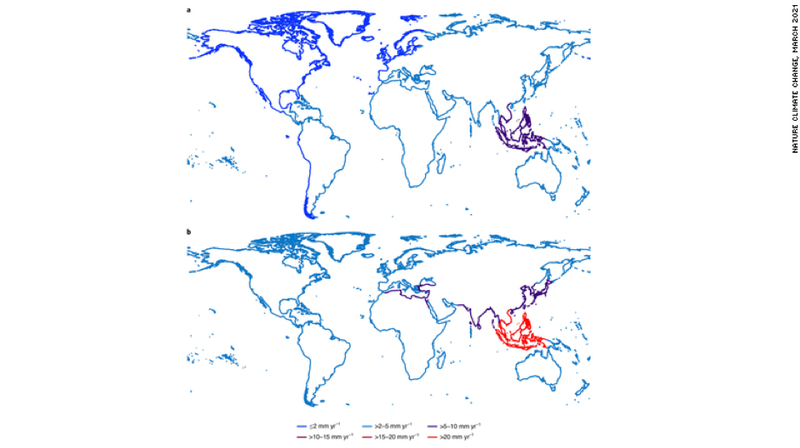May 27, 2021
Sinking land aggravates sea level threat of coastal cities
Coastal city sea level rise impacts and adaptation needs higher than reported due to subsidence
Coastal communities are experiencing relative sea-level rise up to four times faster than the global average, according to a new study which draws on satellite data.
Scientists are already aware of rising global mean sea level, a response to a changing climate, and a trend observed using satellites over the past three decades.
This new global study, published in the journal Nature Climate Change, is the first to consider vertical land shifts – known as subsidence – to determine relative change in sea level rise at the coast.
And the impacts are far larger than the global numbers reported by the Intergovernmental Panel on Climate Change (IPCC).
Faster sea level rise in populous areas
The study shows that coastal inhabitants experienced an average sea level rise of 7.8 - 9.9 mm per year over the past twenty years, some three times faster than the global average rise of 2.6 mm a year.
The team used highly accurate satellite altimetry data from the European Space Agency’s Climate Change Initiative (CCI) to provide information relating to climate induced sea-level change, along with geological measurements that factor in land uplift associated with changes in glacier weight and estimates of subsidence across river deltas and major cities.

“The gridded CCI sea level product was used to estimate sea level rise at 15km from the coast. These were then validated against the coastal sea level dataset also generated by the CCI Sea level project to provide coastal sea level estimates with unprecedented accuracy,” explains Benoit Meyssignac.
ESA's Climate Change Initiative (CCI) generates accurate and long-term satellite-derived datasets for key aspects of the Earth system, including sea level, to support climate science, provide early warning of change and inform policy decisions.
Using these data together, the research team assessed relative sea level change at the coast, weighting their results by population to reflect the potential risk to people.
Relative sea level rise - an uneven trend
Relative changes in sea level revealed interesting trends around the world. Coastal areas in North America experienced falling sea-level result as glacier weight declining and land lifting. These ‘uplifting coasts’ however, while occupying 12.5% of the global coastline, were found to be sparsely inhabited. In contrast, more than one in five people living along the coastline were found to live in coastal areas experiencing a relative increase of sea level of 10 mm or more per year, despite the fact that only 1% of the world's coastline.

According to the authors, this uneven distribution is down to the fact that cities located in river deltas attract large populations and urban development. Deposits of river sediments along with groundwater pumping and mining near the coasts were seen as factors contributing to land in these locations to sinking - compounding the effects of rising sea level.
The regions of most concern cited in the study included South, South East and East Asia as the area has many subsiding deltas and coastal flood plains, growing coastal megacities and host more than 70 per cent of the world's coastal population.
Tackle subsidence to reduce coastal exposure
From a practical point of view, managing subsidence has a higher potential for reducing coastal exposure than climate mitigation over the next 30 years. For example, if coastal city subsidence is reduced to 5 mm per year, population exposure could be reduced by about 20–35 million people or 6–10% by 2050 compared with unreduced city subsidence.
The authors call for the introduction of policies and strategies to maintain the land elevation of coastal cities - while ensuring water resources and other development needs - to guarantee the safety and security of large populations against rising seas and disasters intensified by climate change, particularly in the developing world.
Access and view CCI data
To access all of the Climate Change Initiative's ECV research datasets visit the CCI Open Data Portal. Alternatively o visualise the data visit our Climate from Space public outreach web app.

